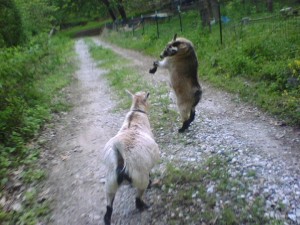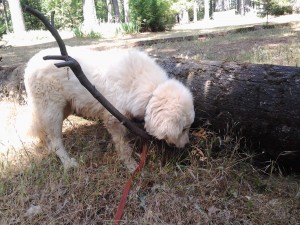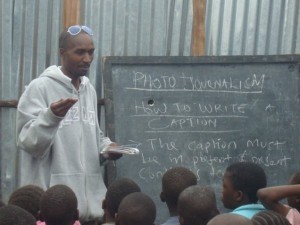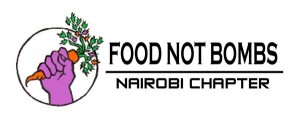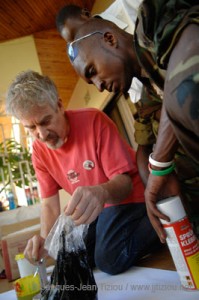Building the Herd: A Study in How Complicated Simplicity Can Be
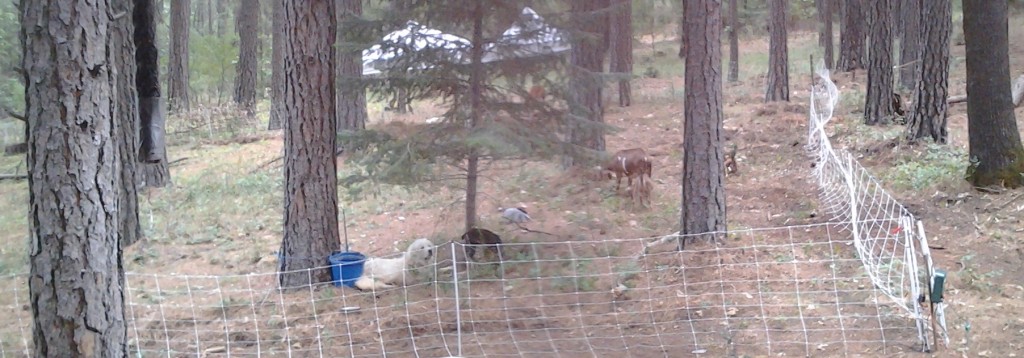 When I started this website and subtitled it “Wren Tuatha’s Complicated Adventures in Simple Living,” I wanted to emphasize the point that simplicity as a value doesn’t mean doing what’s easiest, or even simplest (most expedient) in the moment. Rather, it’s about keeping one’s impacts simplified. That can get very complicated!
When I started this website and subtitled it “Wren Tuatha’s Complicated Adventures in Simple Living,” I wanted to emphasize the point that simplicity as a value doesn’t mean doing what’s easiest, or even simplest (most expedient) in the moment. Rather, it’s about keeping one’s impacts simplified. That can get very complicated!
 I was just rereading The Art of Raising a Puppy, by the Monks of New Skete. They describe the dynamic in which a dog owner who has lost a mature, elderly dog gets an energetic, untrained puppy. They then judge that pup through the biased filter of their old dog’s obedience and socialization. I could easily have that bias as I build a new herd, remembering how my old goats back in Maryland were so free and easy to be with. We had flow. I forget all the years it took to build up to that state of being. I forget the conflicts with my community mates and fetching the goats out of the garden. I forget work sessions to install fencing and to build a cob goathouse.
I was just rereading The Art of Raising a Puppy, by the Monks of New Skete. They describe the dynamic in which a dog owner who has lost a mature, elderly dog gets an energetic, untrained puppy. They then judge that pup through the biased filter of their old dog’s obedience and socialization. I could easily have that bias as I build a new herd, remembering how my old goats back in Maryland were so free and easy to be with. We had flow. I forget all the years it took to build up to that state of being. I forget the conflicts with my community mates and fetching the goats out of the garden. I forget work sessions to install fencing and to build a cob goathouse.
I just remember the easy routine the goats created. Wicca and Niabi were up at sunrise, following their daily path to their preferred morning browsing grounds. When I got up they would make their way back to my cabin to talk to me through the windows. After a long day of circling the woods to find the best browsing in relation to the sun and my comings and goings, they would settle in under the house, preferring to sleep there, close to me, completely forgoing the beautiful cob house we built them in their secure pen.
For the last few years that I had goats in Maryland, their gate was almost always open and their pen was just another part of the woods to be eaten. They had evolved that level of freedom with me through trust, bonding, and experimentation.
But Maryland has surprisingly few mountain lions. The equation of having woodland goats in California is very different. And this herd will be different, in mission and relationship to me.
Before, I had pygmy goats as pets. I committed to them the way I would a dog or cat—for life. That included health care, the highest quality food and entertainment I could afford, and lots of loving. I don’t know what the future has in store for me and these animals. I’m sharing them with my landlords. Many things are different.
Simplicity Concept: Let’s get pet goats to clear brush instead of using chemicals or human hours!
Complication 1: Seriously Apex Predators
Lions, coyotes, and bears! Oh my! In this part of the country, if you have a herd or flock of any kind, even chickens, you either have Livestock Guard Dogs or you have losses. We will spend more on dogs than fencing. Since we are only going to have four goats, I have insisted we only need one dog, Tonka.
He’s an eight month-old Akbash/Anatolian/Great Pyrenees mix. But another herd owner wore me down and talked me into adopting Dana, a ten week-old Akbash pup with a deformed paw. Mandy, who has seventy goats, wanted me to have the pup as, the dogs work best in teams. Although my reading suggests LGD’s take two years to mature into the job, Tonka’s doing an amazing job already. He chased a pair of coyotes off just yesterday. He also alerted us when the bottle baby got stuck in a hole. Dogs are a great addition!
Complication 2: Please Fence Me In!
With mountain lions about, evolving goats into being free range is not realistic. Since we want them to clear brush all around the landlord’s forty acres, we’ll need movable fencing. Technology has marched along and the trend now is
electric netting. The shock is quicker and milder than old style fences and the sections are lightweight and easy to move and install. The power can be household current, battery or solar. In the old days I would have thought this inhumane. I remember the jolts the electric fences on our farm would deliver. But each herd member only has to contact the netting a couple of times and they respect the fence forever. The netting also provides some deterrent to predators.
Complication 3: LGD’s Don’t Know Sit
Livestock Guard Dogs are bread to know their job innately and learn what they don’t know from elders on the job. They’re born with the herd and they bond with goats and other dogs, not so much with humans. Their human handler needs to take alpha rank over the dogs but, like many show dogs, basic obedience is not needed or taught. So when we brought Tonka home, he was used to a leash but didn’t heal, sit, stay or down. Sorry, but if I’m going to handle a herd that includes a dog that could approach a hundred-fifty or two hundred pounds, I need him to sit on command.

Dana drags a leash to aclimate to it. She'll get surgery soon to improve her deformed right front paw.
Although Tonka is unusual in that he’s submissive and people friendly, the pup Dana wants little to do with humans. According to the Monks of New Skete, I’ve got just three weeks or so to socialize her to a variety of humans, otherwise she will have a very hard life if her deformed paw limits her LGD career. So now I’m a dog trainer.
Complication 4: Some Goats Are Gruff
I previously kept pygmy goats, a dwarf breed. My heaviest goat was maybe seventy pounds. I usually got them upon weaning and was very hand-on. Others I got from pet herds. That’s common with pygmies, which are kept more by fanciers than farmers. So I was used to very tame goats. When I got Ponder, the bottle baby, I knew she would grow to one hundred-thirty pounds. But I’m her mama. She’s tame. But the adult wether and young doeling Mandy gave us came from a herd of seventy brush goats. They’re used to seeing humans, but human touch equals unpleasantness—shots, transportation, and this time, rehoming. 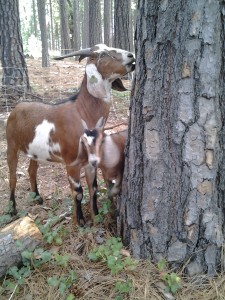 So I have a goat twice the size that I’m used to, he has a huge rack of horns, and he’s not interested in being my friend. Never underestimate the power of feed pellets. You will be mine, Guru!
So I have a goat twice the size that I’m used to, he has a huge rack of horns, and he’s not interested in being my friend. Never underestimate the power of feed pellets. You will be mine, Guru!
Complication 5: Surprise! This Stuff Costs Money!
I’m perfectly clear that I’m starting this herd for enjoyment of their company as well as brush clearing. Otherwise, if brush clearing were the sole benefit, I’m not sure the finances, effort, and time would make good math. Then again, I’ve met several folks who run brush herds for money, so they must make it work on a certain scale. Luckily the landlord and I each have a few collars, halters, leashes, bowls, toys, etc., left over from previous animals. We’re trying to make due with odds and ends we find in these tough economic times. We won’t eat or milk these goats, nor get any fiber from them. So brush clearing and entertainment are our only benefits. But goats and dogs need shots and sometimes have accidents, creating emergency vet bills. Add in puppy food for two and supplemental grains and hay for the goats. Thanks to another goat person, Jen, we’re getting goat milk for the bottle baby. That’s a generous gift, and great savings. The horse barn was already here and the landlord used recycled materials to adapt it to goats. I am repurposing my two EZUp canopies to create shelter in the movable pen.
Simplicity Is Responsibility, not Ease
Live simply so others can simply live. I notice people often falling into a couple of traps in their understanding of Simplicity. One is thinking that it’s about benefits to the individual. I’ve seen it packaged that way, and certainly Americans understand things in individualist terms. People want simplicity to mean more time with their kids, more time for hobbies, less time working an unsatisfying job, fewer possessions by which to be owned. It can be all these things, but this is the shallow end of the pool, and it doesn’t account for simplicity’s complications, as I sketched out above. But going deeper, simplicity is about taking no more than your share of resources, so others can access their shares. Live simply so others can simply live. Modulate your privilege.
The other trap I’m thinking of is the idea that money is the root of all evil and that simplicity must mean a life without money, to the greatest extent possible. I’m not sure, but I’m told that the actual quote is, “the love of money is the root of all evil.” That certainly changes things for me. I see money, like time, labor, etc., as a form of energy. Any energy can be expended for good or bad by anyone. I’ve often said that money can’t buy you love, but it buys you choices. And in a thoughtful simplicity practice, you can choose to spend money to ethically benefit people in your local region and around the world who are trying to simply live.
Simplicity isn’t about you.
—WT
Subscribe to this blog's RSS feed
A Well-Fed Kenya: Food and Photojournalism
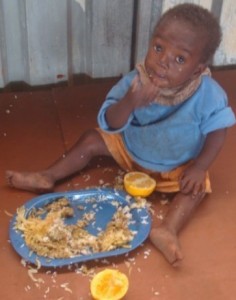 Some stories enter my bones and don’t leave. The story of Nairobi Food Not Bombs is in my marrow and vibrating, refusing to be ignored.
Some stories enter my bones and don’t leave. The story of Nairobi Food Not Bombs is in my marrow and vibrating, refusing to be ignored.
As C.T.’s partner, I’m a witness to the daily news feed of Food Not Bombs arrests and court cases, mostly here in the U.S. In addition, he gets a steady stream of calls all day, mostly people asking advice on consensus and also starting a Food Not Bombs.
One such FNB startup was germinated from C.T.’s trip to Nairobi, Kenya, in 2007. He was there to teach consensus at the IndyMedia Convergence, in advance of the World Social Forum.
IndyMedia is an amazing case study in do-it-yourself journalism, personal and collective empowerment. IMC “converges” at the site of each World Social Forum, a week or so before the WSF begins, to teach grassroots journalism to non-corporate press from all over the world.
The convergences are temporary Intentional Communities that operate by consensus. Workshops teach would be journalists from Africa, South and Central America, Europe and the U.S. in street-level skills like building radios and transmitters out of materials available where they live.
At the Nairobi convergence, C.T. taught consensus and also pulled a hidden skill out of his hat—He taught IMC participants how to build a silkscreen press! This knowledge came from his early days of battling
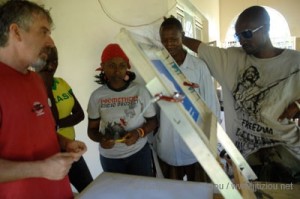
C.T. teaches IMC journalists how to build and use a 3-color silkscreen press to generate fliers, books, posters, t-shirts, etc.
Seabrook Nuclear Power Plant, starting the first FNB collective, the start of ACTUP, etc.
The convergences are meetings of very different cultures. In Nairobi, C.T. was the “old guy.” While the Northerners (Europeans and Americans) gave him little rank and dismissed his efforts to teach, Africans sought him out and revered him as the elder in the group.
One such new friend erased C.T.’s name from a community chore chart and wrote his own in its place. “In my culture, elders do not do the dishes,” He said.
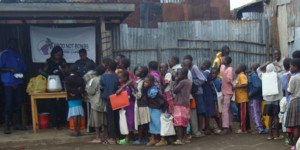 Douglas Rori, a convergence participant who was local to Nairobi, was so taken by C.T.’s stories of Food Not Bombs that he started a Nairobi chapter.
Douglas Rori, a convergence participant who was local to Nairobi, was so taken by C.T.’s stories of Food Not Bombs that he started a Nairobi chapter.
A Totally Different Ballgame
But unlike the twentysomethings who start chapters in their Midwestern college towns or face up against the police in Tampa, Florida, Doug and his Nairobi compatriots couldn’t just show up in the town square or public park with a table and pots of yummy vegan soup.
That’s a recipe for a food riot.
The hunger issue is not a minority issue there. Public feedings such as FNB is famous for the world over would put Doug and other volunteers at physical risk. Plus, with their food stolen, they would not complete their goal of serving the large population of street kids, mostly orphaned in the AIDS epidemic.
Sewing in the IndyMedia Thread
This is where the story gets dramatic in order to prevent drama.
Doug and other young Kenyan activists had the direct experience of how empowering it is to learn tools for telling personal and local stories; to be an alternative to the corporate press party line.
And they had learned filmmaking, photography and journalism in that way. Doug decided to disguise their feedings by offering journalism workshops to the homeless kids.
They chose enclosed courtyards and indoor spaces and spread the word about their workshops. As you can see by the photos, people of all ages came to learn.
And meals were included!
To keep this innovative project going, Doug has formed an NGO, A Well-Fed Kenya, in partnership with A Well-Fed World. This status enables him to operate and seeking funding on an ongoing basis.
Even with NGO status, life is still touch and go for Doug. An IndyMedia colleague was gunned down a few months ago in one of the ghettos, probably an assassination. Doug himself struggles to keep a roof over his own head as he does this important work.
To fund his project and stability for the coming months, we have collaborated with him on an Indiegogo campaign. Please
CLICK HERE TO VISIT OUR CAMPAIGN PAGE,
make whatever contribution you can, and tell your friends Doug’s amazing story! Let’s pull together to keep this project going in the ghettos of Nairobi!
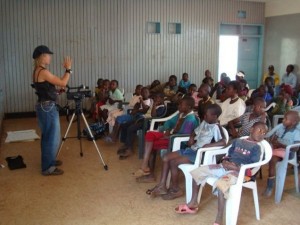 We are starting out with some popular perks from our previous Indiegogo campaign, Food Not Bombs t-shirts and copies of C.T.’s books, On Conflict and Consensus and Consensus for Cities.
We are starting out with some popular perks from our previous Indiegogo campaign, Food Not Bombs t-shirts and copies of C.T.’s books, On Conflict and Consensus and Consensus for Cities.
Doug is also making contact with some fair trade crafts cooperatives and exporters in Nairobi who may be willing to donate some of their jewelry and other crafts as perks for the campaign. So watch for additional perks!!!
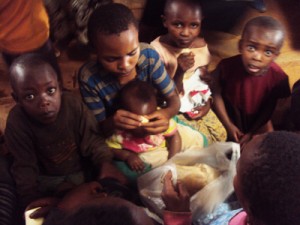 How can you get involved? Certainly, donating whatever you can is a huge start. Are you willing to join our campaign team and use Indiegogo share tools and social media to spread the word? Reaching out to people who don’t already know me, C.T. or Doug Rori is a great help.
How can you get involved? Certainly, donating whatever you can is a huge start. Are you willing to join our campaign team and use Indiegogo share tools and social media to spread the word? Reaching out to people who don’t already know me, C.T. or Doug Rori is a great help.
What ideas do you have for getting the word out about this impactful project?
If you’re in the D.C. region, C.T. and I can schedule a House Party with you. We can supply a slide show, talk about the project with friends you invite, and seek donations. Contact us at fiopa@consensus.net today to make arrangements!
Our main goals for now are to share this amazing story of risk, caring and daring and to get folks to visit our campaign page and donate. We must keep this work going!
When visiting the campaign site, do take the time to go through the photo gallery picture by picture. The interest of the kids in learning from Doug and his friends is amazing. You will understand from the numbers of people who attend that his offering is relevant and is making a difference.
What can you give today?
Owning Our Stories: Building a Silkscreen Press in Nairobi
 It’s always a good day when I wake up to surprise jpegs in my inbox. If you’ve kept up with Hippie Chick Diaries for any time, you know that photos are often the seeds of posts.
It’s always a good day when I wake up to surprise jpegs in my inbox. If you’ve kept up with Hippie Chick Diaries for any time, you know that photos are often the seeds of posts.
Here we see my partner, C.T. Butler, in Nairobi, Kenya, teaching a workshop in how to build a three color silkscreen press.
It was 2007 and C.T. was attending the IndyMedia Convergence in advance of the World Social Forum in Nairobi. When there’s a World Social Forum, 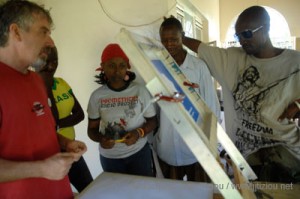 IndyMedia holds a convergence at the location, for a week or so before the event, teaching independent journalists and activists from around the world how to get their stories out using materials at hand. For example, workshops include building radios and transmitters from locally available materials.
IndyMedia holds a convergence at the location, for a week or so before the event, teaching independent journalists and activists from around the world how to get their stories out using materials at hand. For example, workshops include building radios and transmitters from locally available materials.
When their training is done, the journalists and activists are a well-bonded collective that then covers the World Social Forum.
C.T. attended the Nairobi convergence at the invitation of IndyMedia (aka IMC). C.T. is cofounder of the movement Food Not Bombs. The two groups have many cross connections and cross pollinations. Like Food Not Bombs before it, IndyMedia is leaderless, focused on local groups, horizontal in structure, consensus-based, etc.
C.T.’s primary focus was teaching consensus to convergence participants, but his experience in the early days of both FNB and IMC taught him do-it-yourself skills like building a silkscreen press by hand. C.T. often built and used makeshift silkscreen presses in his activism on the east and west coasts of the US.
Activists used the silkscreens to make three color posters, fliers and t-shirts at low cost. Many people are walking around today in Food Not Bombs t-shirts screened by C.T.
 But when C.T. tried to teach this DIY information-sharing tool with activists in Kenya, it was not so easy. Several cultural differences got in the way. First, The most of the African students had not ever held tools like screwdrivers and hammers. Not a universal part of the upbringing.
But when C.T. tried to teach this DIY information-sharing tool with activists in Kenya, it was not so easy. Several cultural differences got in the way. First, The most of the African students had not ever held tools like screwdrivers and hammers. Not a universal part of the upbringing.
Second, there was no Home Depot to go and buy all the supplies and tools. Instead, Nairobi marketplaces had little shops that specialized. There might be an entire shop for screws. That’s all they would have. New, used, mystery screws, chocolate screws, Martian screws…they would have it all, but C.T. found himself going to a dozen different shops, 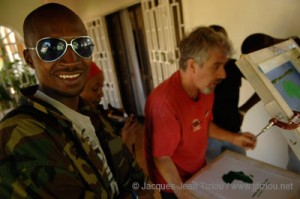 sometimes more than once. Lumber was an odyssey unto itself.
sometimes more than once. Lumber was an odyssey unto itself.
I came into these photos because our friend Doug Rori, in the camouflage jacket, is working with us on a new Indiegogo campaign to fund his work with A Well-Fed Kenya. (More on A Well-Fed Kenya in upcoming posts!) I asked him for pictures of the two of them together, to help tell the story of our collaboration.
I love that what he found were pictures of the silkscreen workshop. C.T. had told me the story several times and it captures my imagination to realize the ways we can take our power back. If we can mass produce our own newspapers, t-shirts, posters, etc., with found materials, then we control our message, we own our stories. This is the profound power of the silkscreen press workshop, like all the others during the IndyMedia Convergence.
[Activists in Mexico made entire copies of C.T.'s book, Food Not Bombs: How to Feed the Hungry and Build Community, in Spanish, on a silkscreen press. His copy is one of his treasured possessions!]
The students and C.T. made a press that day. And today Doug and I will launch our Indiegogo campaign to get the message out about a really amazing, holistic project that feeds many people and teaches them the skills of getting their own messages out every day. Stay tuned!
Where Are We Going Next?
“It’s a dangerous business, going out your front door…
…you step onto the road, and if you don’t keep your feet, there’s no knowing where you might be swept off to.” — JRR Tolkien, The Lord of the Rings
Whew. These days are packed with emails, skypes, livestreams, and every possible electronic communication. Our cellphones ring and ring. There’s a request in every exchange. In between, C.T. and I talk and talk and talk about what’s coming next. What is coming next, you might ask?
Yeah, we don’t know.
The temptation looms large to just go back to New York, embed with OWS and get this consensus thing right. But the call of California hasn’t quieted. Lack of money limits our choices. Maybe we should just stay in DC and get jobs.
Conventional wisdom would ask, “What do you want?” But it isn’t that simple. We are the only people teaching what we’re teaching, Value-Based Consensus. So we can’t just tell people to get someone else to do it, nor can we quickly train other teachers.
Nor can we simply walk away from a direct democracy model which appears to be the one that truly does interrupt privilege and oppression and allow for all voices to be heard. It’s needed at this moment, more than ever.
Part of what we teach are paradigm shifts that support consensus, including a shift from, “What do I want?” to, “What’s best for the group?” The stakes are high. In this case, “the group” is the world, and particularly the activists who would battle economic injustice and climate change.
Strategically, we’d like to be writing books to help the teaching (and funding) go deeper. That’s a yet another direction.
These are baking days.
From Laird Schaub: How Strong to Make the Safety Net
 From Wren: Laird Schaub is a friend from Sandhill Community in Missouri, who teaches facilitation and consensus. He’s active in Fellowship for Intentional Community. Thanks, Laird, for allowing me to repost your article!
From Wren: Laird Schaub is a friend from Sandhill Community in Missouri, who teaches facilitation and consensus. He’s active in Fellowship for Intentional Community. Thanks, Laird, for allowing me to repost your article!
____________________________
About 12 years ago I recall the first time FIC discussed the potential for intentional communities providing a safety net for people with special needs. Under Reagan’s tenure in the ’80s, the federal government went through a massive policy change whereby support for disadvantaged groups was deinstitutionalized. With the Boomer population about to enter retirement age, it didn’t take a math degree to predict the coming train wreck. Why couldn’t communities pick up some of the slack?
There’s no doubt that communities are well structured to offer this kind of help (think about the challenges of aging, mental health, developmental disabilities, physical disabilities, recovery from trauma—there are myriad populations that could benefit from the dignity and caring distinctly possible in group settings). That said, I want to explore the tender dynamics of why it’s hard to take that very far, unless the community makes an explicit choice to go in that direction.
To be sure, there are a number of communities that have chosen to define themselves based on services to disadvantaged segments of the population. Here’s a sampling of some well-established examples:
o Camphill Villages
Inspired by the philosophy of Rudolph Steiner, these groups offer residential support for the developmentally disabled and have been around for 50 years. There are currently 13 offerings in North America, with others abroad.
o Gould Farm
This community in Monterey MA provides residential therapeutic treatment for the mentally ill. It’s been around since 1913—two wall calendars short of a century!
o Innisfree Village
This community in Crozet VA offers support for people with intellectual disabilities and is celebrating its 40th anniversary this year.
o L’Arche
Inspired by the writings of Jean Vanier, this movement started in France in 1964, got a foothold in the US in 1972, and has 17 residential communities in America today, servicing those with intellectual disabilities.
With these solid examples, couldn’t the wider Communities Movement do more on a less formal basis? Perhaps.
Addition by Subtraction
For the most part, intentional communities aim to create a superior lifestyle for their members by purposefully downshifting into the slower lanes of traffic. Community living encourages members to get off the production and consumption treadmill, to slow down, build smaller houses, nurture connections, and share more. Following this path leads to less doing and more being, crafting a quality life on fewer resources. Sure people want security, but this is increasingly being defined as the quality of one’s relationships, rather than the quantity of one’s bank account.
Thus, even as communities aspire to meet their own financial needs, they actively work to whittle down what those needs are, and don’t particularly aspire to make much more than they need.
While most groups willingly stretch to help their own members in need, it is uphill asking communities to set aside resources (or work harder to generate those resources) for the purpose of creating surplus to aid unknown future members. Groups almost never run short of good ideas about how to put surplus resources to use. And if, for some reason, they’re ideas are fully funded, they’re far more likely to ease off the gas and smell more roses now, then to keep chasing dollars and deferring enjoyment of the life’s flower garden to some uncertain future.
Digesting this, it’s understandable that communities rarely get excited about tackling additional responsibilities than the ones they’ve already signed on for. In trying to pioneer sustainable and compassionate culture, they don’t want to swamp their life boat. While they’re typically happy to be an inspiration for other groups focusing on the needs of disadvantaged populations, they’re not likely to take a bigger bite of that particular apple than they already have in their mouth.
The double whammy here is that the disadvantaged groups themselves are, by definition, probably incapable of creating their own communities, and are thus at the mercy of new groups seeing the opportunities in meeting the needs of that client base as a way to ground the community’s mission. While some do, it’s not enough to make up for the (in)difference of contemporary public funding.
We need a different answer, and I think our best hope is for groups to be an inspiration for the neighborhoods and wider communities in which they’re embedded, where the support that intentional communities extend to their members is inspiring for how the many can humanely support the few—without reliance on governmental subsidies.
In an effort to fashion better safety nets, I don’t think we need communities to be salting away more dollars, so much as we need communities to be peppering their neighbors with ideas about how we can create robust services on the local level, built mainly on connection and common sense—giving up on our dependency to a connection with common cents.
Not only do I think we can do it, I think we must.
—Laird Schaub
http://communityandconsensus.blogspot.com/
Are Dragons Nocturnal?
 Are there wild monkeys in Maryland? Do raccoons pitch baseballs? Are dragons nocturnal? I’ve been trying to solve a mystery for the past few nights.
Are there wild monkeys in Maryland? Do raccoons pitch baseballs? Are dragons nocturnal? I’ve been trying to solve a mystery for the past few nights.
I’ve been enjoying the clean forest air, sleeping in a tent behind my cabin on Heathcote Community’s 110 acre wooded land trust. I’m tenting behind my house because, again this year, large black rat snakes have found access into my living space. This time, the story begins with the end of the world:
Remember Harold Camping’s predictions that the world would come to an end last May 21, 2011, at 6pm? Well, around 5pm, I strutted upstairs to where my partner C.T. was napping, to ask him how he wanted to spend the last hour of life. Since we’d just made love about an hour before, I didn’t want to assume he’d choose that. So we sat listing our options when something came crashing down in the kitchen.
“I didn’t like the sound of that,” I said.
“Is the end starting early?” C.T. wondered.
I tip toed about half way down the stairs and hugged the railing as I got confirmation of my fear: There was a four and a half foot black rat snake making its way from a shelf to the top of my refrigerator.
For those of you who don’t follow my website regularly, I don’t own any pet snakes.
“This means I’m not sleeping in this house tonight,” I told C.T. He kept an eye on our intruder’s movements while I gathered up my tent and assorted supplies. We ended up spending a few hours scooping out a level platform for the tent, since the woods is on a slope here. Last year the most level spot we could find still had us inching downhill all night long in our sleep. Now, level and happy, we sleep in a spacious tent while we seek and patch access holes. We have an extension cord and power strip going out to the tent so we have a lovely night stand with a lamp. We can recharge our cellphones and use them for alarm clocks. And we power a fan when needed.
 But even though I’m enjoying the hell out of my tent, someone in the woods is taking exception to my new construction. About a week ago, the assault came from above. With lights out, several times over one night, it sounded almost like someone was dropping a whole bucket of water from above. But it wasn’t raining. The next morning we discovered our rain fly was decorated with some kind of non-mammal excrement. (For this post, I asked C.T. how you spell excrement. He said, “m-e-s-s-y.”) Looking above the area we found very a cool fork of a branch, with an s-shaped twist in it. If I were a bird or a bunch of mating snakes, that would be a comfy roost.
But even though I’m enjoying the hell out of my tent, someone in the woods is taking exception to my new construction. About a week ago, the assault came from above. With lights out, several times over one night, it sounded almost like someone was dropping a whole bucket of water from above. But it wasn’t raining. The next morning we discovered our rain fly was decorated with some kind of non-mammal excrement. (For this post, I asked C.T. how you spell excrement. He said, “m-e-s-s-y.”) Looking above the area we found very a cool fork of a branch, with an s-shaped twist in it. If I were a bird or a bunch of mating snakes, that would be a comfy roost.
But the sheer volume of the excrement and the multiple offenses…snakes? Owl?
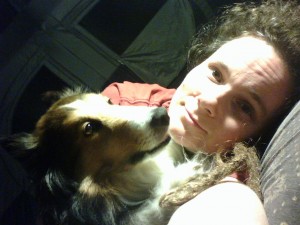 Every night when we enter the tent to go to bed, our dog Tuatha goes with. But he only lasts a few minutes before nuts from the trees above start falling and hitting the tent. Tuatha goes into panic mode and insists we evacuate. And when we show no interest, he scratches on the door of the tent, every dog for himself.
Every night when we enter the tent to go to bed, our dog Tuatha goes with. But he only lasts a few minutes before nuts from the trees above start falling and hitting the tent. Tuatha goes into panic mode and insists we evacuate. And when we show no interest, he scratches on the door of the tent, every dog for himself.
At this point, C.T. calls him scaredy-cat, to which Tuatha has no objection, as long as he can get back into the cabin to spend the night hiding under large heavy furniture. Tuatha apparently prefers the threat of snakes in the house to bombs from above.
For the past few nights, the bombings have been particularly frequent. As a matter of fact, C.T. and I could swear that the nuts are being thrown, not just dropping. They hit so hard. And, here’s the kicker, they’re coming in sideways!
“Maybe the squirrels are annoyed by our lamp and want us to turn out the light,” C.T. guessed.
 “Squirrels are going to stay in their homes at night. They’re not going to risk getting eaten just to throw nuts at us,” I countered. “Although flying squirrels are nocturnal…” We did have a flying squirrel slam into the tent side a couple of nights before.
“Squirrels are going to stay in their homes at night. They’re not going to risk getting eaten just to throw nuts at us,” I countered. “Although flying squirrels are nocturnal…” We did have a flying squirrel slam into the tent side a couple of nights before.
“Maybe they’re frightened or annoyed or jealous of all the sounds we’re making,” C.T. continued, referring to our tendency to be very vocal during sex.
I tried to imagine a squirrel or raccoon with inadequacy issues. “Frightened, maybe,” I answered. “I guess we’re the noisy neighbors of the woods.”
Still we couldn’t place the source or catch anyone in the act. I started pondering the period of time about three years ago when we had other odd occurrences at Heathcote.
I recalled walking in the woods with the Open Classroom kids when we came upon a mass of some almost alien looking substance on the ground, a few feet from the entrance to a small cave. The stuff was greenish-yellowish, slightly more firm than gelatin and in a pile on the leaf litter. There was about a gallon of it.
Was it some kind of fungus or giant frog egg cluster? We couldn’t find any attributes that identified the mass. We were left with only one conclusion, given it’s proximity to the cave: Dragon snot.
 This was the beginning of several months of sightings, almost-sightings, alleged sightings and many clues discovered and debated. At first most of the reports came from kids. But eventually adults also came forward with stories of dragon sightings in the Heathcote forest.
This was the beginning of several months of sightings, almost-sightings, alleged sightings and many clues discovered and debated. At first most of the reports came from kids. But eventually adults also came forward with stories of dragon sightings in the Heathcote forest.
I myself was startled by the dragon up at  Bill Anacker’s house once. I ran a twisted course through the swings in Bill’s yard, barely making it to the front door. The dragon was on my heels so near, that I had to dive trough the oversized doggie door. I didn’t even have time to turn a door knob!
Bill Anacker’s house once. I ran a twisted course through the swings in Bill’s yard, barely making it to the front door. The dragon was on my heels so near, that I had to dive trough the oversized doggie door. I didn’t even have time to turn a door knob!
Over time, sightings became less frequent. I haven’t heard of any lately. But now, with this anomalous event of nuts, dirt clumps and feces being thrown at our tent, I wonder.
There’s nothing like a tent, made of polyfiber only a couple of millimeters thick, staked under fifty-foot trees in a hundred acre wood, to give one pause about one’s place in nature and the food chain. Turn out the light, listen to the quiet of the night, then have it disturbed by tiny bombs, bombs that have been falling to Earth every year for millenia.
For millenia, animals like me have been discovering dragons.
—WT
Please join our Hippie Chick Diaries fan page on Facebook!
Social Technology Toolbox Summer Camp July 15-24, 2011
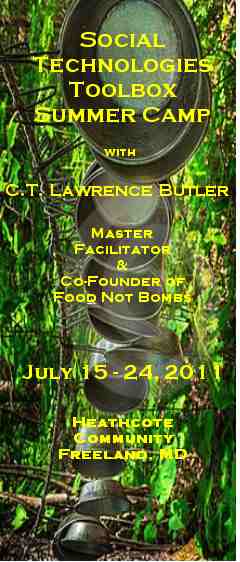
 How did we come up with the idea for a toolbox summer camp? C.T. Butler and I have been exploring how Intentional Communities and other groups succeed and how they understand (or often misunderstand) consensus. The idea of a “toolbox,” which members regularly update and use to build new culture, solve conflicts and grow as people, isn’t a new idea. What goes in it varies but adding to it seems key.
How did we come up with the idea for a toolbox summer camp? C.T. Butler and I have been exploring how Intentional Communities and other groups succeed and how they understand (or often misunderstand) consensus. The idea of a “toolbox,” which members regularly update and use to build new culture, solve conflicts and grow as people, isn’t a new idea. What goes in it varies but adding to it seems key.
More than just a technique like Non-Violent Communication, “consensus is a cultural paradigm…a way of being in the world,” writes trainer Maikwe Schaub Ludwig. Yet few people get much more than a day or two of training in this “way of being.” Many more find themselves practicing it with no training!
A space happened to open up in Heathcote Community’s education calendar. And when C.T. and I considered it for a weekend slot, we realized we had the chance to really help people go deep and get it!
We sprang into action and put together many of the ideas we’d been collecting. Ta dah! Toolbox Camp!
Below is the text of our brochure:
Are you currently part of an organization, activist group, non-profit, Cohousing or Intentional Community that’s having trouble with governance, decisionmaking or communication?
• Does your group feel a time pressure when making decisions?
• In discussions, does everyone speak?
• Does your group accomplish its goals?
• Do some people dominate? Is there burnout?
• Is the workload uneven? Organizational structure vague?
• Does it seem members just don’t hear each other?
C.T. Butler and Wren Tuatha been going deeper into the nature of consensus, how to teach it and how to help groups succeed. We’ve gotten clear that consensus is amazing and transformative, but that it’s a major paradigm shift for most groups. It’s more than just exchanging Robert’s Rules for Butler’s. C.T. isn’t just offering new software, so to speak, but a whole new operating system.
We are offering these skill building experiences designed to help Communities, activist groups, non-profits, spiritual groups, families, etc., succeed in their goals through awareness of the structures of group dynamics—decisionmaking, conflict resolution, mediation, listening, and communication that integrates head, heart and gut.
SOCIAL TECHNOLOGY TOOLBOX SUMMER CAMP
July 15-24, 2011
A 10 day immersion, starting with a weekend workshop called Consensus, Body and Soul. Then, together, we’ll create temporary consensus-based community. The mornings will be devoted to ZEGG Forum and deeper consensus workshops. Each 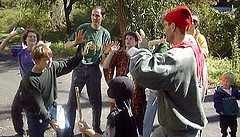 afternoon, we will add techniques and perspectives like Enneagrams, JoHari Window, Spiral Dynamics, Heart of Now, etc. The group will make decisions together at plenaries and participants can offerπ content of their own each evening through Open Space Technology.
afternoon, we will add techniques and perspectives like Enneagrams, JoHari Window, Spiral Dynamics, Heart of Now, etc. The group will make decisions together at plenaries and participants can offerπ content of their own each evening through Open Space Technology.
Simply, we’re all about finding the voice of the group. After thirty years in the field of consensus, C.T. presents a clear vision of egalitarian freedom through use of structure that brings the common values to life within the group.
 Some lessons are collected from other wise travelers, others are plucked from our own experiences in groups. Even as we make our offerings, the paradigm is leaderless and participant generated. We are curious about you. What do you bring?
Some lessons are collected from other wise travelers, others are plucked from our own experiences in groups. Even as we make our offerings, the paradigm is leaderless and participant generated. We are curious about you. What do you bring?
LOGISTICS
Request a brochure with the application form at curiocoast@comcast.net. Costs include fixed fees for materials, food and lodging, and a sliding scale for tuition.
Structured programming begins Friday evening, July 15. and ends at noon on Sunday, July 24. Lodging options are camping and the Heathcote Mill bunkroom. 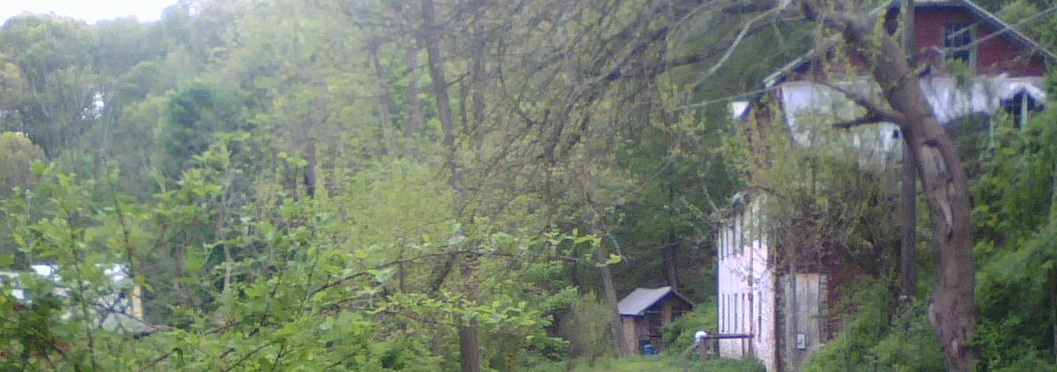 Accommodations are rustic and, like most forests, the land does have poison ivy/oak and ticks that carry lyme disease. Heathcote is a vegetarian facility, and drug and alcohol free. Carpooling is encouraged. You will receive a packet with directions, a Heathcote orientation, packing lists, schedules and other logistics upon registration. The packet will include requests for food allergy and other special needs information.
Accommodations are rustic and, like most forests, the land does have poison ivy/oak and ticks that carry lyme disease. Heathcote is a vegetarian facility, and drug and alcohol free. Carpooling is encouraged. You will receive a packet with directions, a Heathcote orientation, packing lists, schedules and other logistics upon registration. The packet will include requests for food allergy and other special needs information.
Please join our Hippie Chick Diaries fan page on Facebook!
FREDERICK, MARYLAND POW-WOW SCHEDULED FOR May 2011: Frederick Food Bank TO Benefit From Pow-Wow
Forwarding a press release.—WT:
Hollister, NC- Pow-Wow, an American Indian owned and operated company, will sponsor the Frederick, Maryland American Indian Pow-Wow and Show at the E-Eventplex at the Frederick Fairgrounds (797 E. Patrick Street Frederick, MD 21705) on May 21-22, 2011. The Pow-Wow is an opportunity for the public to interact with American Indian dancers, singers, drummers, artists and craftspersons. This event is an attempt by Pow-Wow to educate the public about American Indians, past and present, through the arts.
The pow-wow is an opportunity for the public to interact with over 100 American Indian dancers in regalia (outfits), singers, drummers, artists, and crafts persons. Over $8,000 will be offered in dance and drum prizes, which will attract more than 100 dancers in full regalia from throughout the United States and Canada. At least Five (5) drums are expected.
On Saturday, gates will open at 11:00AM, and the event will kick off with a parade of nations (grand entry) at 12:00 noon. Over 50 Tribes will be represented at this year’s event, and they include: Haliwa-Saponi, Piscataway, Chickahominy, Rappahannock, Cherokee, Sioux, Iroquois, Lumbee, Hopi, Mattaponi, Nansemond, Choctaw, Navajo, and so many other Tribes and nations.
Hoop Dancer Pete Four Winds (Mohawk) and Juan Salinas of the Aztec Dancers will perform both days.
Fun activities for children include: Storytelling by Rose Powhatan, pony rides, face painting, tipi visit, bow ‘n’arrow shooting and a make it/take it table.
The public will be able to purchase some of the finest Native American crafts available. Items for sale include turquoise jewelry, moccasins, beadwork, rugs, books, paintings and dreamcatchers to name a few. Buffalo stew, fried bread, Indian corn soup and buffalo burgers are just a few of the Native American food items that will be on sale at the event.
Admission to the Pow-Wow is as follows: Friday-$10 for everyone Saturday –Sunday: Ages 3-12: $6:00 Ages 13-up: $10.00. The Frederick Food Bank will benefit from the Frederick Pow-Wow. A donation of a non-perishable food item at the gate on Saturday or Sunday will allow a person/family to receive $1 off each ticket purchased. This offer is not good with any other offer. Please call Ms. Sarah McAleavy, Coordinator of Food and Nutrition at Frederick Food Bank for more info concerning our food drive. Her number is (301) 600-6263.
For more information regarding the pow-wow, please call the show promoter at (252) 586-7913 or (252) 532-0821 or send e-mail to: powwow@vance.net This is not a web-site.
OUR WEB-SITE IS: http://www.myspace.com/powwow4life
TELEVISION AND PHOTO OPPORTUNITES
FREDERICK, MARYLAND AMERICAN INDIAN POW-WOW SCHEDULE-UPDATED
May 21, 2011
11:00AM-Gates Open/Vendor Sales
12 Noon-Grand Entry/Parade of Native American Dancers
1:00PM-Moccasin Blowout-Exhibition
1:00: Storyteller-Rose Powhatan
1:15: Hoop Dancer-Pete Four Winds
1:30-3:00PM-Native American Dancers-Exhibitions-1st round of contests
3:00-3:15: Storyteller-Rose Powhatan
3:15-3:30: Hoop Dancer-Pete Four Winds
3:30PM-4:00PM-Juan Salinas, Aztec Dancer
4:00PM-Moccasin Blowout Competition-1st Round
4:30PM-6:30PM-Native American Dancers/Contests/Exhibitions/Specials/honors-2nd round of contests
7:00PM-Gates Close
May 22, 2011
11:00AM-Gates Open/Vendor Sales
12 Noon-1:30PM-Grand Entry/Parade of Native American Dancers/Exhibitions
1:30PM-1:45PM-Storytelling: Rose Powhatan
1:45PM-2:00PM: Hoop Dancer-Pete Four Winds
2:00-3:30PM-Native American Dancers-Exhibitions-2nd round of contests
3:30PM-Juan Salinas-Aztec Dancer
3:50PM-Moccasin Blowout Competition-2nd Round
4:00PM-6:00PM-Native American Dancers/Contests/Exhibitions/Specials/honors-2nd round of contests
6:00PM-Announcementt of winners
6:00PM-Gates Close
Please join our Hippie Chick Diaries fan page on Facebook!
Graffiti: The Subversive’s Hymnal in the Age of Earth, Inc.
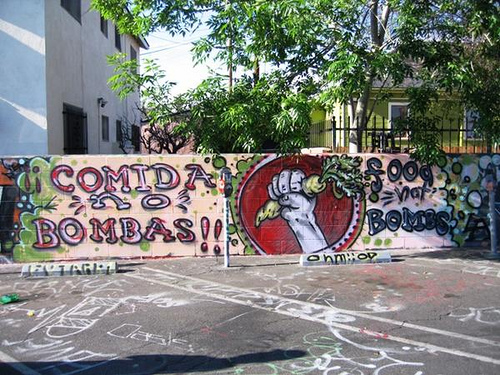 Although many of us in the Intentional Communities movement know C.T. Butler as a consensus trainer/ facilitator/mediator and the author of On Conflict and Consensus and Consensus for Cities, he is also the fountainhead and co-founder of the original Food Not Bombs collective. He’s co-author of Food Not Bombs: How to Feed the Hungry and Build Community, with FNB co-founder Keith McHenry.
Although many of us in the Intentional Communities movement know C.T. Butler as a consensus trainer/ facilitator/mediator and the author of On Conflict and Consensus and Consensus for Cities, he is also the fountainhead and co-founder of the original Food Not Bombs collective. He’s co-author of Food Not Bombs: How to Feed the Hungry and Build Community, with FNB co-founder Keith McHenry.
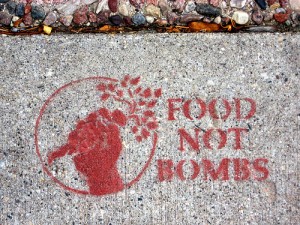 In his role as consensus trainer, he met Douglas Rori in Nairobi, Kenya. Both were attending the IndyMedia Convergence leading up to the World Social Forum there four years ago. They’ve stayed in touch and C.T. has closely supported Doug’s work in establishing a FNB chapter in Kenya. So when Doug posted his new film on facebook recently, I was electrified by the parallels of the use of graffiti in Africa with the stories C.T. has told me about graffiti as a central artistic tool in FNB and his other activism in the 1980’s. Of course, the artistic bar has been shot into the stratosphere, as depicted in the thought provoking documentary Exit Through the Gift Shop. And the art in Doug’s film is of that caliber.
In his role as consensus trainer, he met Douglas Rori in Nairobi, Kenya. Both were attending the IndyMedia Convergence leading up to the World Social Forum there four years ago. They’ve stayed in touch and C.T. has closely supported Doug’s work in establishing a FNB chapter in Kenya. So when Doug posted his new film on facebook recently, I was electrified by the parallels of the use of graffiti in Africa with the stories C.T. has told me about graffiti as a central artistic tool in FNB and his other activism in the 1980’s. Of course, the artistic bar has been shot into the stratosphere, as depicted in the thought provoking documentary Exit Through the Gift Shop. And the art in Doug’s film is of that caliber.
I want to share Doug’s link because, wherever activists are working, I love the power of delivering our messages on our own terms. This seems more and more important as we find ourselves living on Earth, Inc.
http://vimeo.com/20684850
Please join our Hippie Chick Diaries fan page on Facebook!
May 22 Fundraiser for Heathcote Land, Permaculture; Features Jamie Anderson
 In my world, Permaculture education and comedic Lesbian folk music are a luscious combination, like chocolate and peanut butter. Remember those Reese’s commercials in which one person is walking down the street eating a chocolate bar and someone is walking towards them eating from a jar of peanut butter and they’re both so self absorbed that they don’t see the other, collide, and their food gets combined, thus delivering them to a higher level of Nirvana? Well, Jamie Anderson probably has a song about that.
In my world, Permaculture education and comedic Lesbian folk music are a luscious combination, like chocolate and peanut butter. Remember those Reese’s commercials in which one person is walking down the street eating a chocolate bar and someone is walking towards them eating from a jar of peanut butter and they’re both so self absorbed that they don’t see the other, collide, and their food gets combined, thus delivering them to a higher level of Nirvana? Well, Jamie Anderson probably has a song about that.
I’ve been keeping it in the back of my mind that I’d like to get Jamie to Heathcote Community for our House Concert Series, and now that chocolaty muse has collided with Heathcote’s exciting new opportunity: An adjoining piece of land which we’ve always held dear is for sale, giving us a chance to greatly expand our organic farming and Permaculture education programs. Oooh! Peanut butter!
The Anacker Land
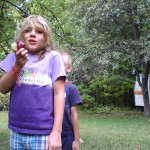 Heathcote Community was founded in 1965 when Bill and Margaret Anacker, members of the School of Living, sold a 37 acre parcel of their land to SoL as a headquarters for the magazine Green Revolution and as a homesteading demonstration site. As a 1960’s & 70’s style hippie commune sprouted and grew on the land, Bill and Margaret were very involved, mentoring young folks in homesteading and sustainability skills. The community overlapped onto other parts of the Anackers’ land and the community evolved into a wimmin’s land through the 80’s and eventually a mixed queer & straight community of settled members. Over time, Heathcote acquired parcels we call the Farmhouse land and Cabin land, or, Back 70, both of which had previously been the Anackers’, and which helped us expand our membership and unify our little valley.
Heathcote Community was founded in 1965 when Bill and Margaret Anacker, members of the School of Living, sold a 37 acre parcel of their land to SoL as a headquarters for the magazine Green Revolution and as a homesteading demonstration site. As a 1960’s & 70’s style hippie commune sprouted and grew on the land, Bill and Margaret were very involved, mentoring young folks in homesteading and sustainability skills. The community overlapped onto other parts of the Anackers’ land and the community evolved into a wimmin’s land through the 80’s and eventually a mixed queer & straight community of settled members. Over time, Heathcote acquired parcels we call the Farmhouse land and Cabin land, or, Back 70, both of which had previously been the Anackers’, and which helped us expand our membership and unify our little valley.
 Now with Margaret passed on and Bill needing eldercare, the Anacker family is selling the 24 acre parcel on which Bill and Margaret homesteaded for so long. This land would give Heathcote our first substantial ridge top acreage, suitable for gardening/farming we haven’t been able to do down in our narrow valley and flood plain. This would allow us to expand our Permaculture education, internships and community membership, and provide crops for donation, Community Supported Agriculture (CSA) and/or market gardening, as well as allowing Heathcote to increase our food self-sufficiency.
Now with Margaret passed on and Bill needing eldercare, the Anacker family is selling the 24 acre parcel on which Bill and Margaret homesteaded for so long. This land would give Heathcote our first substantial ridge top acreage, suitable for gardening/farming we haven’t been able to do down in our narrow valley and flood plain. This would allow us to expand our Permaculture education, internships and community membership, and provide crops for donation, Community Supported Agriculture (CSA) and/or market gardening, as well as allowing Heathcote to increase our food self-sufficiency.
We have some substantial pledges from large donors, starting us on our way. We’re partnering with Fusion of Baltimore as our fiscal sponsors. We’ve formed a fundraising committee and seek broad community support for bringing the Anacker land into the community.
Award winning singer-songwriter/parking lot attendant Anderson plays tunes that go from sexy to silly, witty to whimsical. She first hit my radar when Louisville DJ and Yer Girlfriend vocalist Laura Shine played her music at a time when we were first launching our Fairness Campaign there. She’s been on my playlist ever since!
She draws from many influences. As her website explains: She’s country without the big hair, bluegrass without the whiny tenor, blues without selling her soul and rock without the dirty t-shirt.
Besides songs that range from laugh out loud to tugging on your heartstrings, Jamie is adept at improving witty, thoughtful intros and stories. Her shows are great entertainment on many levels!
When Jamie isn’t touring, she’s taught songwriting, guitar and other classes at Duke University, arts centers, privately and at festivals all over the country. She has a chapter in Songwriting and the Guitar, a book that also includes Paul Simon, The Indigo Girls, Joni Mitchell and others. Jamie is a freelance writer whose articles and CD reviews have appeared in Acoustic Guitar, Curve, SingOut! and more.
Anderson’s awards include Finalist (USA Songwriting Competition, “Your Mama Scares Me,” 2008), the Jane Schliessman Award for Outstanding Contributions to Women’s Music (Women in the Arts, 2006), Best Folk Album (The Independent, A Promise of Light, 2005), Honorable Mention (Great American Song Contest, “Beautiful,” 2005), and others that only her mama cares about.
Save the date: May 22, 7pm. And stay tuned to Hippie Chick Diaries for more articles with links to Jamie’s songs and details about our silent auction and plant sales!
Please join our Hippie Chick Diaries fan page on Facebook!
